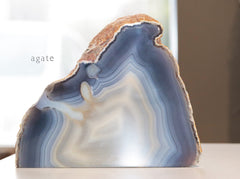
Agate vs. Jasper
Agate vs. Jasper
Introduction
Sometimes the bead industry uses names that aren’t always scientifically correct or precise. This issue often appears when the names “Agate” and “Jasper” are used interchangeably to describe the same material. So how do you know which is accurate? The easiest test is visual. Put light behind the material - If you can see light through it, it’s an Agate. If you can’t, it’s a Jasper.
Agates and Jaspers are often the most common rocks that people go hunting for. Sometimes they can even form together, known conveniently as Jasp-Agates! Jasper and Agate are actually both a part of the Chalcedony family. Chalcedony stones are made up of microcrystalline Quartz, which means the Quartz particles are microscopic. Chalcedony stones rank a 7 on the Mohs Hardness Scale. Agates and Jaspers cannot be identified by color alone because both stone types have a huge color variety.
Agates

Agates are typically found in places that have had volcanic activity. The silica that forms from volcanic activity gets dissolved by the rainwater that washes away volcanic ash, and the water turns into silica gel that eventually crystallizes into microcrystalline Quartz. Agates will usually harden into the shape of whatever space they form in and they can also form in layers, resulting in the gorgeous lines you typically see in the stones!
Jaspers

Jaspers, while they have the same structure as Agates, are not transparent at all. They form in a very similar way that Agates form, with one exception. When silica gel flows along the ground, impurities get mixed into it and often add color to the gel during the crystallization process. These different types of impurities are what makes the color opaque instead of transparent, resulting in Jasper stones.
Note: At Dakota Stones, we choose to use trade names for materials in most cases. We make every effort to identify both other common names for a stone, as well as to fully disclose the composition of a stone within each product description. Not all opaque material is Jasper, nor is all translucent material Agate. This article is meant to help readers understand why similar materials may bear different names or have characteristics at odds with them.

Comments
Leave a comment